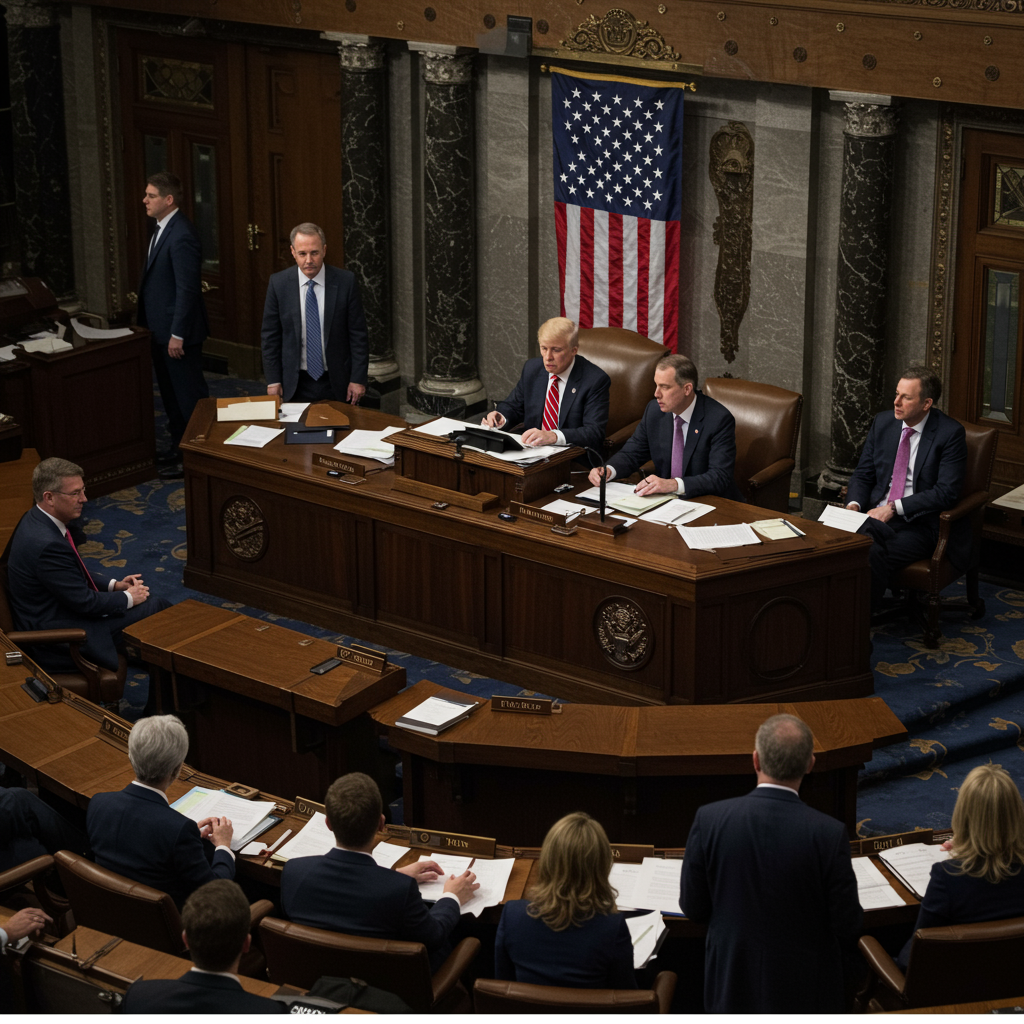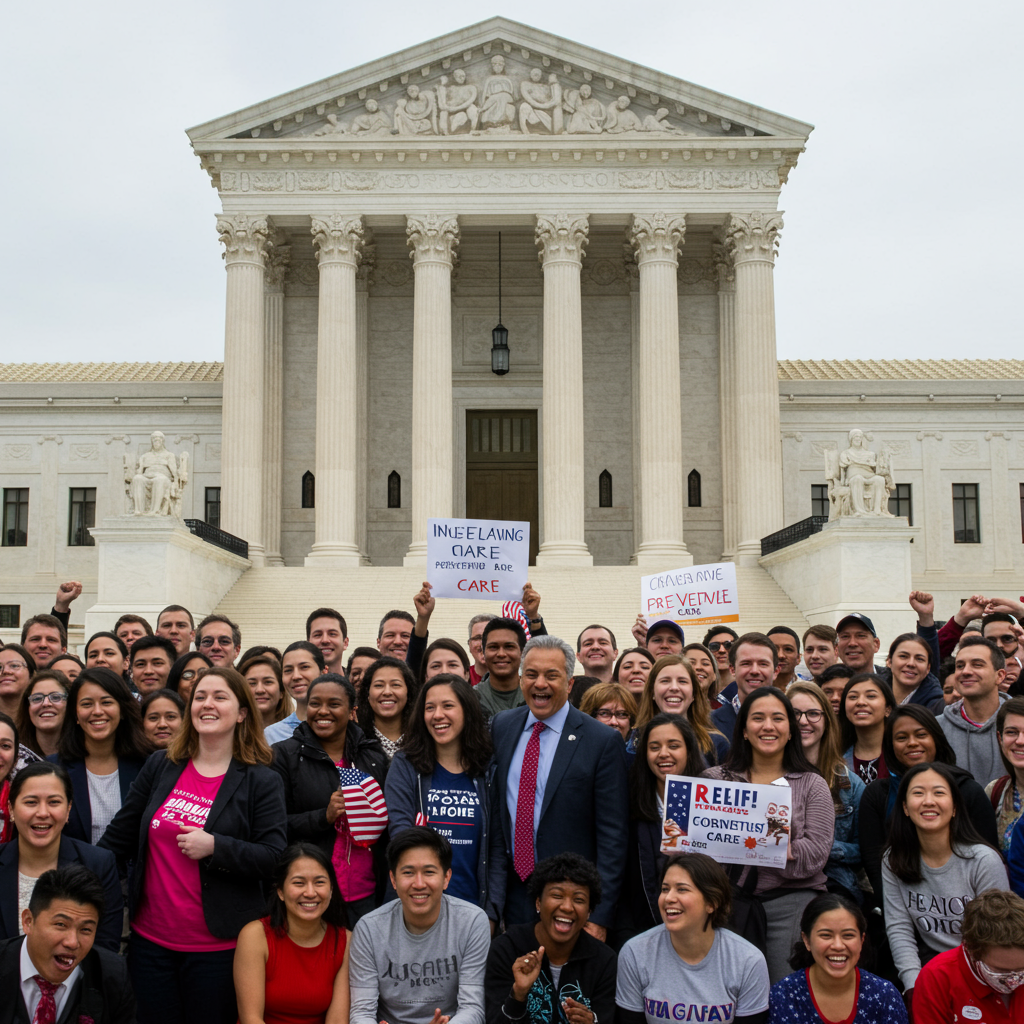A critical legislative showdown is unfolding in the U.S. house of Representatives. Lawmakers are intensely debating a sweeping tax and spending bill championed by former President Donald Trump. This follows a dramatic overnight session. Republicans successfully advanced the controversial measure toward a final vote despite internal party divisions. The bill, central to Trump’s future agenda, includes major tax cuts and significant spending shifts. Its potential impacts on healthcare, safety nets, and the national debt are sparking fierce opposition.
High-Stakes debate Underway
The House floor is now the battleground for the final debate on this consequential legislation. The process began after a lengthy procedural vote. Republican leaders worked through the night to secure enough votes to move the bill forward. That crucial vote passed early Thursday morning by a narrow 219-213 margin. This paves the way for the main debate and an expected final vote later today. The slim Republican majority of 220-212 means leadership can only afford a few defections. This makes the final outcome uncertain despite the procedural victory.
Democrats Launching Strong Opposition
Democratic Minority Leader Hakeem Jeffries has been leading the charge against the bill. He utilized an unlimited speaking time allowance on the House floor. His speech extended for over four hours. This marathon address was explicitly intended to delay the final vote.
Jeffries did not mince words. He called the bill an “abomination.” He also described it as “catastrophic,” “punishment,” and a “crime scene.” Referencing Trump’s own moniker, Jeffries labeled it “one big ugly bill.”
Democrats argue the legislation disproportionately benefits the wealthy. They say it provides massive tax breaks for billionaires and corporations. At the same time, they contend it implements severe cuts to essential safety net programs. Jeffries used powerful language. He stated the bill takes a “chainsaw” to Medicare and Medicaid. He also claimed it targets nutritional assistance for hungry children and vulnerable Americans.
Democratic criticism highlighted potential harm to everyday Americans. They cited estimates that millions could lose health insurance. This impact falls heavily on seniors, veterans, and low-income families. Jeffries questioned why the debate began in the early hours if Republicans were proud of the bill. He declared Democrats are determined to “take a chainsaw to Project 2025.” This positioned their opposition as a counter-strike against a perceived conservative agenda.
Unpacking the Controversial Bill’s Components
The legislation encompasses a wide range of President Trump’s top domestic priorities. It merges tax policy changes with significant spending and cuts.
Key provisions include:
Tax Cut Extensions: Making permanent the tax cuts enacted in Trump’s 2017 legislation. Analysis suggests the largest benefits accrue to the wealthiest households.
Safety Net Cuts: Imposing deep reductions to health and food assistance programs. This includes substantial cuts to Medicaid, Obamacare, and the Supplemental Nutrition Assistance Program (SNAP). New or expanded work requirements for beneficiaries are part of this effort.
Immigration Enforcement Funding: Allocating approximately $45 billion for Immigration and Customs Enforcement (ICE). This funding is intended for increased border security and new detention facilities.
Energy Policy Shifts: Zeroing out many incentives previously established for green energy initiatives.
- Debt Ceiling Increase: Authorizing a $5 trillion increase in the nation’s debt ceiling.
- www.theguardian.com
- www.cbsnews.com
- www.theguardian.com
- www.cbsnews.com
- www.theguardian.com
The non-partisan Congressional Budget Office (CBO) provided stark estimates. They project the bill would add roughly $3.3 trillion to the federal deficit over the next decade. The CBO also estimated that nearly 12 million people could lose health insurance coverage due to the health care cuts, particularly impacting Medicaid beneficiaries.
Republican Push and Internal Hurdles
Despite Democratic opposition, Republicans are pushing hard for the bill’s passage. House Speaker Mike Johnson and Majority Leader Steve Scalise have expressed confidence. They believe they have the votes necessary to send the bill to the President’s desk.
However, uniting the Republican caucus proved challenging. The party’s narrow majority meant leadership had to navigate internal dissent. Both moderate Republicans and members of the conservative House Freedom Caucus expressed concerns. These holdouts were reportedly unhappy with changes made to the bill by the senate. The Senate version included steeper cuts to Medicaid. It also proposed a higher increase to the debt limit. Alterations to green energy policies and state and local tax (SALT) deduction provisions also caused friction.
Former President Trump played a very active role. He engaged directly with dissenting lawmakers. He met with holdouts and made phone calls throughout the night. Speaker Johnson acknowledged Trump’s involvement was “very, very helpful.” He said Trump offered “assurances” about future legislative steps. Trump also used his Truth Social platform. He posted messages pressuring Republicans during the procedural vote.
The Fight to Advance: A Procedural Saga
The process to advance the bill to the floor debate was fraught with difficulty. The crucial procedural rule vote, expected Wednesday evening, stretched for hours. Republican leaders kept the vote open late into the night and early morning. They engaged in intense discussions with hesitant members. Their goal was to convince them to switch their votes. At one point, multiple Republicans were voting ‘no’ or had not voted. This was enough opposition to potentially block the measure. Ultimately, leadership successfully persuaded enough holdouts. When the vote closed around 3:20 a.m. Thursday, only one Republican, Rep. Brian Fitzpatrick, remained opposed to the rule. This narrow victory allowed the debate to commence.
The Bill’s Path Through the Senate
Before reaching the House floor for final debate, the bill navigated the Senate. It narrowly passed the Senate in a 51 to 50 vote. Vice President JD Vance cast the decisive tie-breaking vote. This occurred after over 24 hours of amendment votes and debate.
Senate Majority Leader John Thune was credited with securing the needed votes. He persuaded GOP holdouts despite significant concerns. Three Republicans – Sens. Thom Tillis, Rand Paul, and Susan Collins – ultimately voted against final passage with all Democrats. Some Republican senators raised concerns about the deficit impact. Others focused specifically on the substantial Medicaid cuts. Senator Lisa Murkowski described her decision as “agonizing.” She highlighted the impact on vulnerable populations in her state.
The bill was advanced using the budget reconciliation process. This allows passage with a simple majority. It bypasses the need for the 60 votes typically required to overcome a filibuster. The Senate version included changes that necessitated the bill’s return to the House for approval.
What’s Next? Racing Against the Clock
Following the House debate, a final vote is expected. If the House passes the bill without changes, it can head directly to the President. If the House amends the Senate version, it must return to the Senate for another vote. Lawmakers are reportedly aiming for a July 4th signing deadline. Making changes in the House would make meeting that target challenging. The legislative clock is ticking rapidly.
Public and Political Reactions Diverge
Reaction to the bill spans a wide spectrum, even within the Republican base. Some Trump supporters view it positively. They see it as needed fiscal reform and a way to curb bureaucracy. Others, including many typical GOP voters, express significant skepticism or outright opposition. They raise concerns about the cuts to safety nets, the increase in the national debt, and whether the tax benefits truly reach the middle class. This division highlights the complex political landscape surrounding the bill. Democrats remain unified in their forceful condemnation. They argue the bill prioritizes tax cuts for the wealthy over the needs of vulnerable Americans.
Frequently Asked Questions
What are the key provisions of Trump’s tax and spending bill being debated in the House?
The bill would make permanent the 2017 Trump tax cuts. It includes major spending cuts to health and food safety net programs like Medicaid and SNAP. It also allocates billions for increased immigration enforcement and detention facilities. Additionally, it proposes zeroing out many green energy incentives and increases the national debt limit by $5 trillion.
How could the proposed cuts to programs like Medicaid and SNAP affect Americans?
Democrats and non-partisan analyses warn of significant negative impacts. The CBO estimated nearly 12 million people could lose health insurance coverage due to Medicaid cuts. Critics argue these reductions would harm vulnerable populations. This includes children, seniors, veterans, and people with disabilities who rely on these programs for essential support and nutrition.
Where does the bill stand now and what are the next steps in the legislative process?
The bill has passed the Senate and is currently being debated on the floor of the U.S. House of Representatives. Following the debate, the House is expected to hold a final vote on the measure. If passed, it could go to the President’s desk. However, if the House makes changes, the bill must return to the Senate for re-approval before it can become law.
Conclusion
The debate in the U.S. House over this major tax and spending bill marks a critical moment. It pits Republican priorities of tax reduction and spending cuts against Democratic concerns over social safety nets and the national debt. With a narrow House majority and internal party dynamics at play, the path to final passage remains fraught. The outcome will have significant implications for the U.S. economy, social programs, and the political landscape heading forward.




